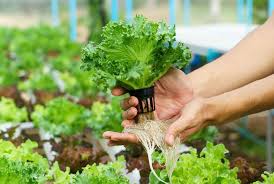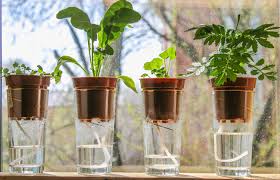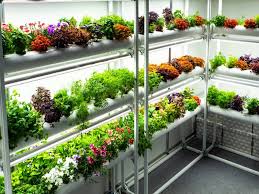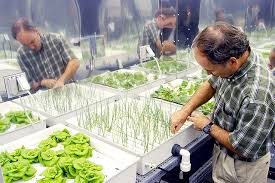Indoor hydroponic gardening is a modern method of growing plants without soil, using nutrient-rich water solutions instead. This innovative technique allows gardeners to cultivate a variety of plants, from herbs and leafy greens to fruits and flowers, all within the comfort of their homes.
With the rise in urban living and limited outdoor gardening space, indoor hydroponics has gained popularity as an efficient and sustainable alternative to traditional gardening methods.
One of the primary benefits of indoor hydroponic gardening is its ability to produce healthy, fresh food year-round, regardless of the season or weather conditions outside. Since hydroponics allows for controlled environmental conditions, plants can thrive in a stable climate with the right temperature, light, and humidity.
This control not only enhances plant growth but also reduces the risk of pests and diseases that often plague outdoor gardens.
Furthermore, hydroponic systems are designed to use less water compared to conventional gardening. In a traditional garden, water can evaporate or be absorbed by the soil, leading to significant waste.
In contrast, hydroponics recirculates water through the system, ensuring that plants receive only what they need. This efficiency makes hydroponics an environmentally friendly choice, especially in regions facing water scarcity.
Setting up an indoor hydroponic garden can be simpler than one might think. With the right equipment and knowledge, anyone can transform a small space, such as a kitchen countertop or a corner of a living room, into a thriving garden.
Various hydroponic systems, such as nutrient film technique (NFT), deep water culture (DWC), and aeroponics, cater to different preferences and skill levels. Each system has its advantages, allowing gardeners to choose the one that best fits their lifestyle and available space.
Additionally, indoor hydroponic gardening fosters a deeper connection to the food we consume. Growing plants from seed to harvest provides a sense of accomplishment and satisfaction that store-bought produce often lacks. It encourages individuals to learn about plant biology and nutrition, promoting healthier eating habits.
As gardeners observe the growth process, they gain insight into the importance of sustainability and the impact of food choices on the environment.
Moreover, indoor hydroponic gardens can significantly enhance indoor air quality. Plants naturally filter the air, removing toxins and releasing oxygen. This improvement in air quality contributes to a healthier living environment, making hydroponics not just a way to grow food but also a means to create a more enjoyable home atmosphere.
Indoor hydroponic gardening offers numerous benefits, making it an appealing option for anyone interested in growing their own food, improving their living space, and fostering a more sustainable lifestyle.
Whether you’re a seasoned gardener or a complete novice, this guide will provide you with the essential information needed to embark on your hydroponic gardening journey, helping you cultivate a flourishing indoor garden that brings joy and nourishment to your home.
Benefits of Hydroponic Gardening

1. Space Efficiency: Hydroponic systems allow for vertical gardening, maximizing the use of limited space, making them ideal for urban environments or small backyards.
2. Faster Growth Rates: Plants grown hydroponically often mature faster than those in soil, as they receive a direct supply of nutrients and optimal growing conditions, leading to quicker harvests.
3. Water Conservation: Hydroponics uses significantly less water than traditional soil farming. The closed-loop systems recycle water, reducing waste and promoting efficient usage.
4. Reduced Pesticide Use: Hydroponic systems can minimize pest problems due to controlled environments. This reduces the need for chemical pesticides, resulting in healthier produce.
5. Year-Round Production: With hydroponics, you can grow plants throughout the year, regardless of weather conditions, by controlling temperature, light, and nutrients, leading to continuous harvests.
Types of Hydroponic Systems
1. Nutrient Film Technique (NFT): In this system, a thin film of nutrient solution flows over the roots of plants housed in a sloped channel, allowing for efficient nutrient uptake.
2. Deep Water Culture (DWC): Plants are suspended in a nutrient-rich oxygenated solution, with roots submerged in water, providing easy access to nutrients and oxygen.
3. Ebb and Flow (Flood and Drain): This system periodically floods the grow bed with nutrient solution, then drains it back into the reservoir, allowing plants to absorb nutrients while aerating their roots.
4. Wick System: A passive system where wicks draw nutrient solution from a reservoir to the growing medium, suitable for small plants and less intensive operations.
5. Aeroponics: In aeroponics, plants are suspended in air and misted with a nutrient solution, promoting faster growth due to increased oxygen exposure to the roots.
Read Also: 5 Medicinal Health Benefits Of Yucca glauca (Soapweed Yucca)
Essential Equipment for Hydroponic Gardening

1. Grow Lights: Since natural sunlight may be insufficient, especially indoors, grow lights are crucial for providing the right spectrum and intensity of light to support plant growth.
2. Pumps and Tubing: Pumps are needed to circulate nutrient solutions through the system, while tubing transports the solution to and from plant sites, ensuring adequate nutrient delivery.
3. pH and EC Meters: Monitoring pH and electrical conductivity (EC) is essential for maintaining nutrient balance; these meters help ensure optimal growing conditions.
4. Reservoir: A container that holds the nutrient solution; it should be durable and appropriately sized to accommodate the plants being grown.
5. Growing Medium: While hydroponics primarily uses water for nutrients, a growing medium (like rock wool, coconut coir, or perlite) supports plant roots and retains moisture.
Choosing the Right Location for Your Setup
1. Accessibility: Ensure your hydroponic garden is easily accessible for maintenance tasks like watering, harvesting, and monitoring plants. A convenient location encourages regular care.
2. Sunlight Exposure: If growing indoors, choose a spot with ample natural light or space for grow lights. A well-lit area promotes photosynthesis, crucial for plant growth.
3. Temperature Control: Select a location with stable temperatures, ideally between 65°F and 75°F (18°C to 24°C). Extreme temperatures can stress plants and hinder growth.
4. Ventilation: Good air circulation is vital to prevent mold and pests. Ensure your setup is in a well-ventilated area or has fans for air movement.
5. Proximity to Water and Electricity: Ensure your location has easy access to water sources and electrical outlets to support pumps, lights, and other equipment.
Read Also: 17 Medicinal Health Benefits Of Saffron (Crocus sativus)
Selecting Plants for Hydroponic Gardening

1. Leafy Greens: Varieties like lettuce, spinach, and kale thrive in hydroponic systems due to their quick growth and low nutrient requirements, making them ideal for beginners.
2. Herbs: Basil, cilantro, and mint grow well hydroponically, requiring minimal space and offering high market value for culinary uses.
3. Fruiting Vegetables: Tomatoes, peppers, and cucumbers can be successfully grown in hydroponic systems, although they may require more care regarding nutrients and support.
4. Strawberries: These are a popular choice in hydroponics, producing sweet fruit while benefiting from the controlled environment, leading to fewer pests and diseases.
5. Microgreens: Fast-growing and nutrient-rich, microgreens are perfect for hydroponics, offering a quick turnaround and high demand in the market.
Nutrient Solutions for Hydroponics
1. Complete Nutrient Solutions: These commercially prepared solutions contain essential macro and micronutrients like nitrogen, phosphorus, potassium, calcium, magnesium, and trace elements for optimal plant growth.
2. Custom Nutrient Mixes: Depending on the plants you grow, you may need to adjust nutrient concentrations. Tailoring mixes ensures that specific plant needs are met at different growth stages.
3. pH Adjustment Solutions: Maintaining the proper pH (typically between 5.5 and 6.5) is crucial for nutrient absorption. Use pH up or down solutions to maintain ideal levels in your hydroponic system.
4. Organic Nutrient Options: For those preferring organic methods, various organic nutrient solutions are available that support healthy plant growth while adhering to organic farming principles.
5. Monitoring and Adjusting Nutrient Levels: Regularly check nutrient levels using EC meters, adjusting concentrations based on plant growth and health to prevent deficiencies or toxicities.
Managing Light Conditions for Optimal Growth
1. Light Spectrum: Use grow lights that provide a full spectrum of light, focusing on blue light for vegetative growth and red light for flowering and fruiting stages.
2. Light Duration: Most plants require 12 to 16 hours of light daily for optimal growth. Use timers to ensure consistent light cycles that mimic natural conditions.
3. Distance from Plants: Position grow lights at an appropriate distance to avoid burning plants. Generally, LEDs can be placed closer (12-24 inches) than traditional bulbs (24-36 inches).
4. Monitoring Light Levels: Use a light meter to measure the intensity of light received by plants, adjusting the height of grow lights as needed to maintain optimal conditions.
5. Natural Light Integration: If growing indoors, place your setup near windows or utilize light tubes to maximize natural light while supplementing with artificial lighting when necessary.
Water Quality and Maintenance
1. Source Quality Water: Start with clean water free from chlorine, heavy metals, and contaminants. Use filtered or distilled water to prevent issues with nutrient uptake.
2. Regular Testing: Test the water regularly for pH (ideal range is 5.5 to 6.5) and electrical conductivity (EC) to ensure nutrients are at appropriate levels for plant growth.
3. Temperature Control: Maintain water temperature between 65°F and 75°F (18°C to 24°C). Cooler temperatures help oxygen retention, while warmer water can lead to algae growth.
4. Oxygenation: Use air stones or pumps to aerate the water, ensuring adequate oxygen levels. Well-oxygenated water promotes healthy root systems and reduces the risk of root rot.
5. Change Water Regularly: Replace the nutrient solution every 1-2 weeks, depending on plant growth and consumption rates, to prevent nutrient imbalances and bacterial growth.
Common Challenges and Troubleshooting
1. Algae Growth: Prevent algae by keeping your growing area dark or using opaque containers. If algae develops, reduce light exposure and consider adding hydrogen peroxide to your water.
2. Nutrient Deficiencies: Monitor plants for signs of nutrient deficiency, such as yellowing leaves or stunted growth. Adjust your nutrient solution based on identified deficiencies.
3. Root Rot: Ensure proper drainage and aeration in your system to prevent root rot. If it occurs, remove affected plants and treat remaining roots with a fungicide.
4. Pests and Diseases: Regularly inspect plants for pests like aphids or spider mites and diseases such as powdery mildew. Use organic pest control methods to manage infestations effectively.
5. System Failures: Be prepared for pump or power failures by having backup systems in place. Regular maintenance checks can prevent many mechanical issues.
Harvesting and Maintaining Your Hydroponic Garden
1. Harvesting Techniques: Use sharp scissors or pruning shears to avoid damaging plants during harvesting. Harvest leafy greens by cutting the outer leaves, allowing the inner leaves to continue growing.
2. Timing Your Harvest: Harvest at the right time based on plant maturity and desired flavor. For example, herbs are best harvested just before flowering for maximum flavor.
3. Cleaning and Sanitizing Equipment: After harvesting, clean tools and equipment to prevent the spread of diseases. Use a diluted bleach solution or commercial sanitizers to disinfect.
4. Post-Harvest Handling: Handle harvested produce gently to avoid bruising. Store greens in a cool, dark place or refrigerate them in breathable bags to maintain freshness.
5. Regular Maintenance: Continuously monitor plants for growth and health, adjusting light, water, and nutrients as needed. Regular pruning can help promote bushier growth and better air circulation.
Tips for Success in Indoor Hydroponic Gardening
1. Research and Planning: Before starting, research suitable plants for your hydroponic system and plan your setup based on available space, light, and resources.
2. Choose the Right System: Select a hydroponic system that fits your skill level and space, such as Deep Water Culture (DWC) for beginners or Nutrient Film Technique (NFT) for more experienced gardeners.
3. Keep a Gardening Journal: Track plant growth, nutrient levels, and any issues you encounter. This record helps you make informed adjustments and improves future harvests.
4. Network with Other Growers: Join online forums or local gardening clubs to exchange tips, troubleshoot problems, and share experiences with fellow hydroponic enthusiasts.
5. Stay Patient and Adapt: Be patient as plants grow and adapt to your hydroponic system. Experiment with different plants and techniques, learning from both successes and challenges.
Do you have any questions, suggestions, or contributions? If so, please feel free to use the comment box below to share your thoughts. We also encourage you to kindly share this information with others who might benefit from it. Since we can’t reach everyone at once, we truly appreciate your help in spreading the word. Thank you so much for your support and for sharing!
Read Also: How to Grow Tomatoes in Containers






